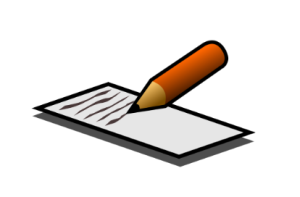7 RtI/MTSS – Writing

Writing Interventions
The implementation of evidence-based writing practices in a comprehensive and systematic way can significantly enhance students’ writing development and empower them to become effective written communicators. It can help students build their confidence as writers as they learn the essential elements of writing and the writing process. It is important for all educators to understand the individual components of written expression so that they can support their students when interventions might be needed, no matter what grade level or subject area they might teach.
Strategic Written Instruction
Writing instruction must happen strategically and systematically with opportunities for students to plan, draft, revise, edit, and peer review as they build their confidence in writing skills. Teaching explicit writing strategies for planning, drafting, revising, and editing involves breaking down the writing process into doable steps. It can help to provide students with specific techniques for each stage, like teaching brainstorming techniques, outlining strategies, or methods for self-correction.
Self-Regulated Strategy Development (SRSD)
This is a well-researched approach that combines explicit strategy instruction with self-regulation strategies like goal setting, self-monitoring, and self-reinforcement. SRSD has shown significant positive effects across various writing tasks and student populations. This strategy can support students of a variety of grade levels. There are six stages of self-regulated strategy development. These strategies are: develop background knowledge, discuss it, model it, memorize it, support it, and establish independent practice (IES, 2017). This strategy has been proven effective for students with writing learning disabilities and those who have struggled with Tier 1 and Tier 2 interventions. Teachers may need to repeat and reuse some of these strategies as students begin to show progress with them.
Process Writing
This strategy provides students with regular opportunities to engage in the writing process. This includes pre-writing activities (brainstorming, outlining), drafting, revising, (which includes making substantive changes to content and organization), editing (correcting errors in grammar, mechanics, and spelling), and publishing (sharing finished work). Research about writing instruction highlights the importance of teaching students’ specific revision strategies, such as adding details to writing, clarifying ideas, reordering information, and strengthening arguments.
Explicit Instruction in Writing Elements
This strategy includes explicitly teaching sentence construction and combining sentences together to make a complete thought. It involves guiding students on how to create more complex and robust sentences and how that improves the quality of their writing. Sentence combining activities have been found to be particularly effective in writing intervention
Grammar and writing mechanical instruction within the context of writing are important strategies to consider while using this strategy. Grammar instruction alone has limited impact, but teaching grammar and mechanics as needed during the writing process can assist students in applying these skills more effectively. In addition to grammar instruction, explicitly teaching vocabulary, especially words relevant to specific writing tasks, can enhance students’ ability to express their ideas with clarity and purpose.
Mentor Texts
Writing instruction mentor texts means giving students access to high-quality examples of different writing genres and styles. This gives them exemplars and helps them understand the expectations and possibilities for their own writing. Giving students the opportunity to analyze these models can reveal effective writing techniques.
Collaborative Writing
This strategy looks like giving students the opportunity to work together on writing tasks that includes planning, drafting, and revising, providing opportunities for peer learning and feedback. Structured collaboration among students where the teacher gives them clear roles and expectations is the most effective way to implement this strategy.
Feedback
Targeted writing instruction must include the step where the teacher gives feedback that focuses on specific aspects of writing. The teacher should offer concrete suggestions for improvement. Feedback can also come in the form of peer feedback as well, but it should always be overseen by the teacher. In the case of Tier 2 and Tier 3 interventions, peer review feedback is less appropriate than teacher feedback, to ensure that students are getting the foundational support they need to build good writing habits. When using peer review strategies in Tier 1 intervention, teaching students how to give and receive feedback effectively can empower students to learn from each other and develop their critical evaluation skills in addition to their writing skills.
Goal Setting
During this step, teachers should encourage students to set goals for their writing. Goal setting can increase student motivation and focus toward completing writing goals. Goals can be scaffolded to support student growth and individual needs related to the writing process, for example, complete a draft by a certain date or improve the quality of the writing.
Writing About Reading
Writing about reading includes integrating writing activities with reading instruction, which can happen in any class, in any grade level, and across small group, large group, or one-on-one settings. This can occur by asking students to begin with writing or sentence prompts and then they can write summaries, quick responses, or comprehensive analyses of what they have read. This strategy helps to deepen and extend their reading comprehension and as a bonus, strengthens their writing skills.
To learn more, watch these YouTube videos:
YouTube Video: “4 Ways to Motivate Students to Write / Solutions for Unmotivated Writers in Elementary Classrooms” by April Smith, Literary Specialist
Additional Resources
Evidence-based practices for writing instruction
References
Institute of Education Sciences. (2017, November). WWC intervention report: Self-regulated strategy development. U.S. Department of Education.

